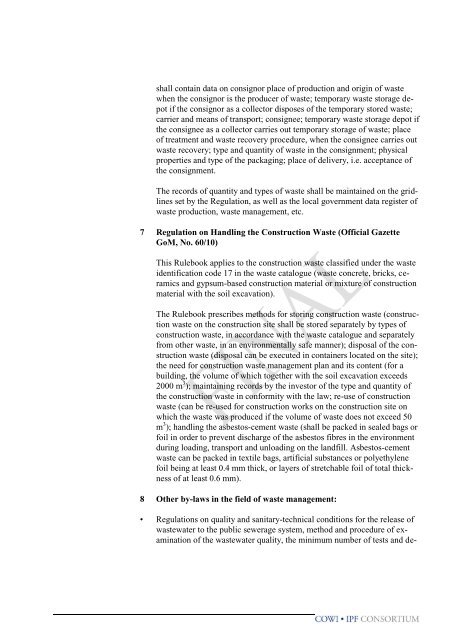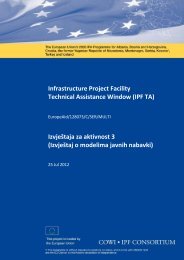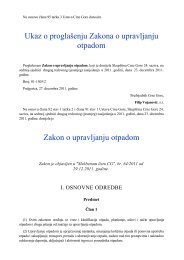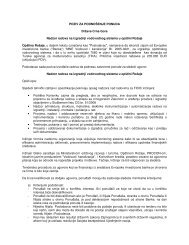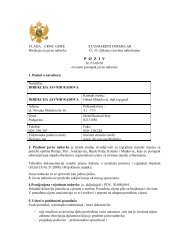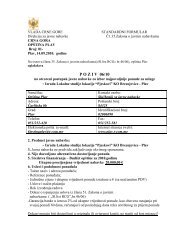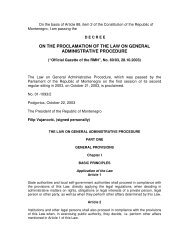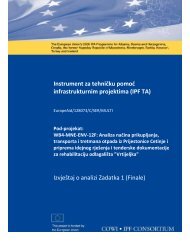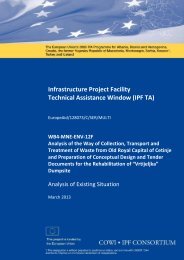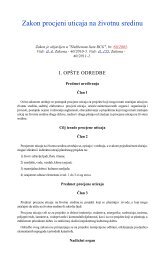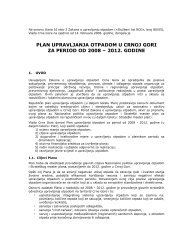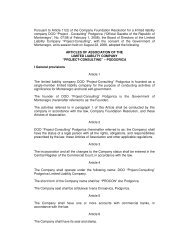Infrastructure Projects Facility Technical Assistance Window (IPF TA ...
Infrastructure Projects Facility Technical Assistance Window (IPF TA ...
Infrastructure Projects Facility Technical Assistance Window (IPF TA ...
Create successful ePaper yourself
Turn your PDF publications into a flip-book with our unique Google optimized e-Paper software.
shall contain data on consignor place of production and origin of waste<br />
when the consignor is the producer of waste; temporary waste storage depot<br />
if the consignor as a collector disposes of the temporary stored waste;<br />
carrier and means of transport; consignee; temporary waste storage depot if<br />
the consignee as a collector carries out temporary storage of waste; place<br />
of treatment and waste recovery procedure, when the consignee carries out<br />
waste recovery; type and quantity of waste in the consignment; physical<br />
properties and type of the packaging; place of delivery, i.e. acceptance of<br />
the consignment.<br />
The records of quantity and types of waste shall be maintained on the gridlines<br />
set by the Regulation, as well as the local government data register of<br />
waste production, waste management, etc.<br />
7 Regulation on Handling the Construction Waste (Official Gazette<br />
GoM, No. 60/10)<br />
This Rulebook applies to the construction waste classified under the waste<br />
identification code 17 in the waste catalogue (waste concrete, bricks, ceramics<br />
and gypsum-based construction material or mixture of construction<br />
material with the soil excavation).<br />
The Rulebook prescribes methods for storing construction waste (construction<br />
waste on the construction site shall be stored separately by types of<br />
construction waste, in accordance with the waste catalogue and separately<br />
from other waste, in an environmentally safe manner); disposal of the construction<br />
waste (disposal can be executed in containers located on the site);<br />
the need for construction waste management plan and its content (for a<br />
building, the volume of which together with the soil excavation exceeds<br />
2000 m 3 ); maintaining records by the investor of the type and quantity of<br />
the construction waste in conformity with the law; re-use of construction<br />
waste (can be re-used for construction works on the construction site on<br />
which the waste was produced if the volume of waste does not exceed 50<br />
m 3 ); handling the asbestos-cement waste (shall be packed in sealed bags or<br />
foil in order to prevent discharge of the asbestos fibres in the environment<br />
during loading, transport and unloading on the landfill. Asbestos-cement<br />
waste can be packed in textile bags, artificial substances or polyethylene<br />
foil being at least 0.4 mm thick, or layers of stretchable foil of total thickness<br />
of at least 0.6 mm).<br />
8 Other by-laws in the field of waste management:<br />
• Regulations on quality and sanitary-technical conditions for the release of<br />
wastewater to the public sewerage system, method and procedure of examination<br />
of the wastewater quality, the minimum number of tests and de-<br />
.


